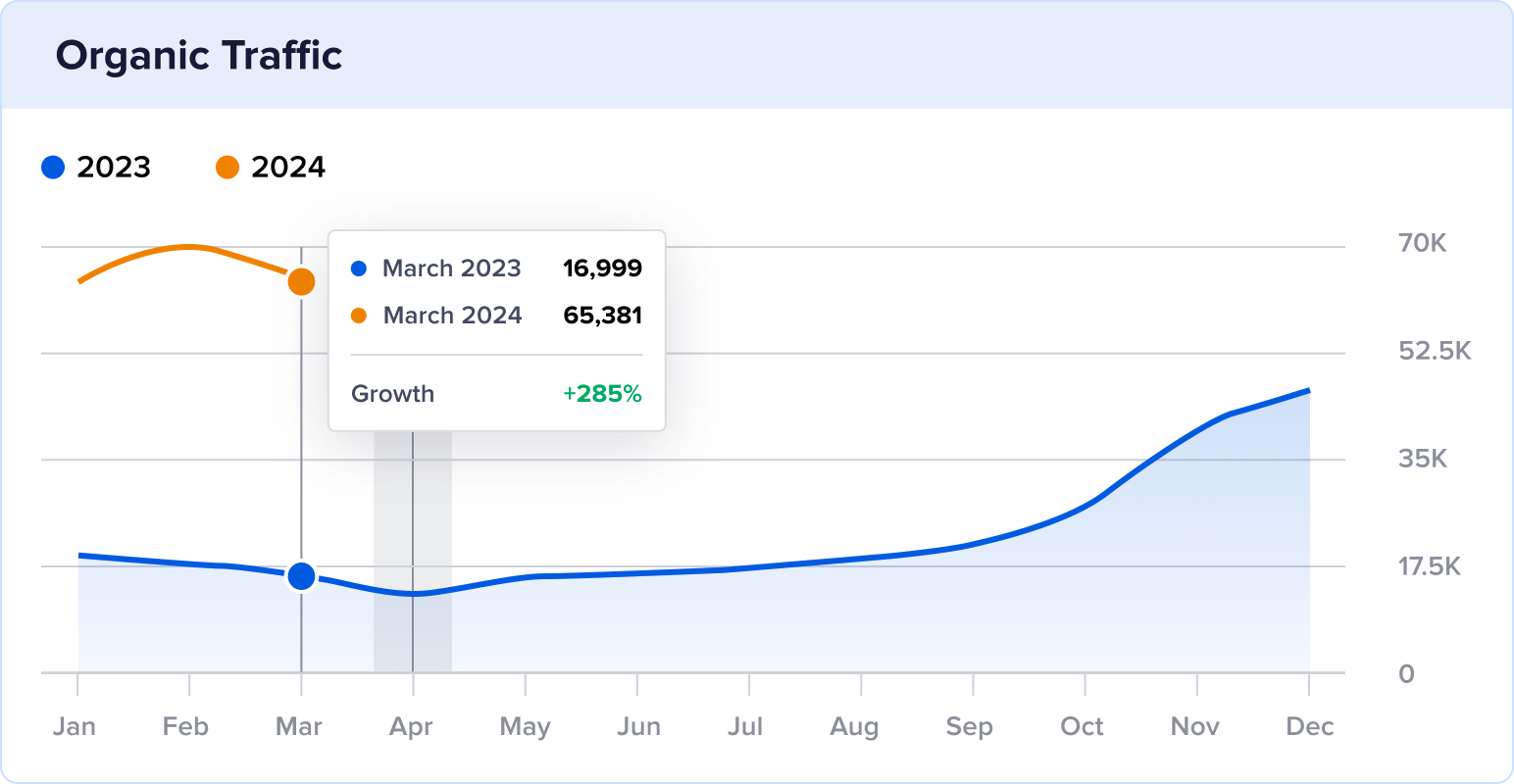How the Oxford English Dictionary Grew Traffic by 1,041% in 3 Months
https://www.oed.com/
Stats
331K to 3.8M Monthly Visits
Industry
Digital Publishing
Niche
Educational
Reporting Date
November 2023
Comfort with the familiar often breeds complacency. After all, navigating the unknown takes less effort than accepting the status quo.
However, sometimes, those most resistant to change can be the ones with the most to gain.
In this SEO case study, we’ll unravel the digital transformation of the Oxford English Dictionary.
Not only did they acknowledge the need for change in 2023, but they embraced it with remarkable results.
Join us as we discuss how they pioneered a new era of growth and how website owners can learn from their success to grow their site traffic.
Let’s get started.
In This Article
About the Oxford English Dictionary
The Oxford English Dictionary (OED) is a leading historical dictionary of the English language.
It boasts a rich history, dating back to 1857 in the United Kingdom.
The first publication was issued in 1884, although it remained a work in progress until its completion in April 1928.
Over generations, the OED has been no stranger to transformations of the times.
1987 marked the production of the first CD, and in 2000, OED launched its first website.
Now, as we analyze oed.com in November 2023, the website has been redesigned. This iteration is the state of OED we’ll be exploring today.
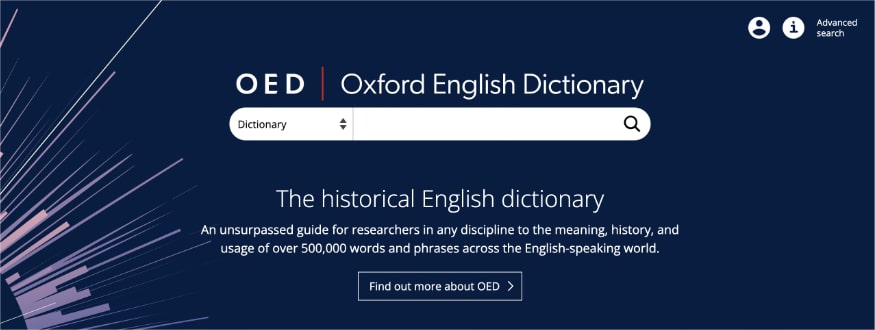
The homepage states that users can get the “meaning, history, and usage of over 500,000 words and phrases across the English-speaking world.”
Users can access dictionary entries, which share the following information:
- Factsheet
- Meaning & use
- Etymology
- Pronunciation
- Frequency
The example below demonstrates all these elements, organized in tabs.
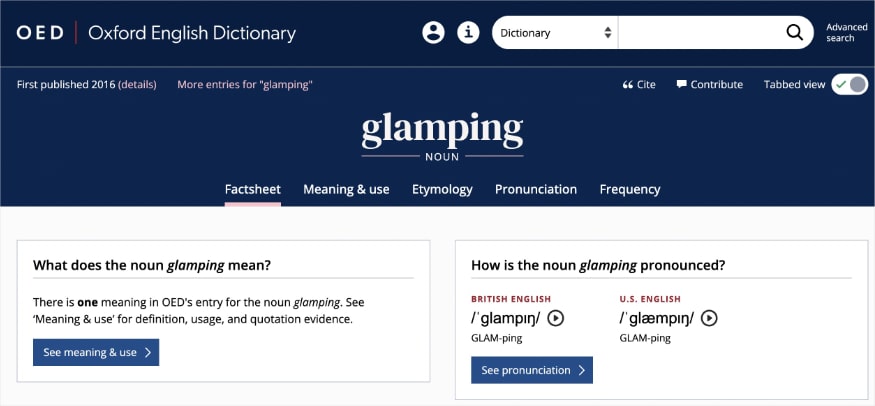
It’s important to note that OED content currently adheres to a freemium model, meaning some content is free while others require a paid subscription to view.
(This was not always the case. Before the website design, much of the content was locked behind a paywall, but we’ll get more into that later.)
For now, let’s look at how oed.com performed over the last decade.
Historical Performance
Semrush historical data reveals that organic traffic has stayed relatively consistent over the past 10 years.

On average, OED garnered 470K organic monthly visits from 2012 to 2022.
This figure saw a modest uptick in 2023, averaging 491K visits from January to September.
However, the real turning point occurred in October. Traffic reached an unprecedented high, surging to 2.4 million visits.
And now, in November 2023, OED has reached a staggering 3.8 million visits.
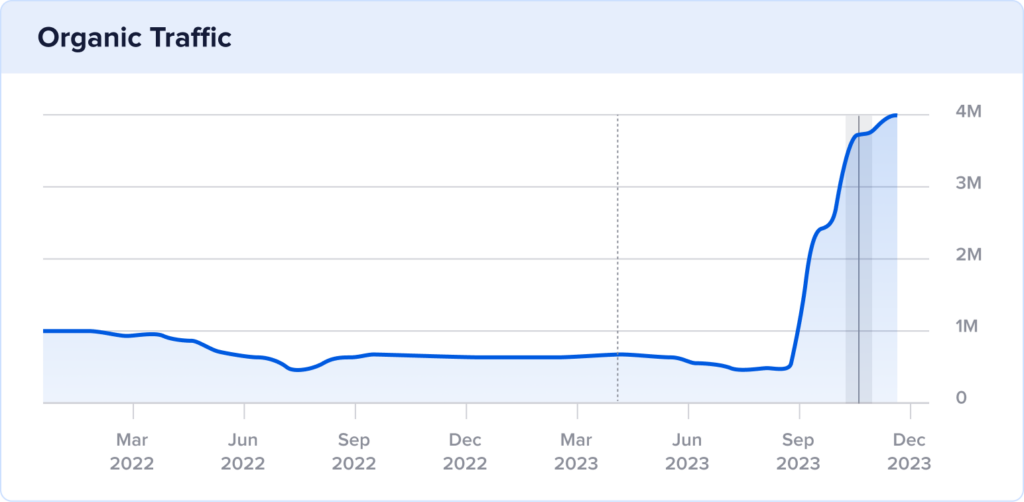
So, what exactly happened in the latter part of 2023 to ignite such dramatic growth?
We’re revealing those answers next.
The Catalyst: How OED Achieved 1,041% Growth in 3 Months
Oed.com grew its organic traffic by performing the following:
- Launching website redesign with SEO-friendly URLs
- Transitioning to a freemium model with Factsheets
- Leveraging questions to rank in Google’s People Also Ask box
We’ll delve into each of these strategies to understand its role in OED’s newfound SEO success.
1. Launching a Website Redesign With SEO-Friendly URLs
In the summer of 2023, OED announced its plans to move to a new software platform.
They aimed to provide an improved user experience with clearer navigation and enhanced functionality.
Their announcement also revealed the intent to improve discoverability by search engines.
The latter point is the focus of our first strategy.
At the end of July, OED revealed its new website.
Visually, the difference was striking. But it was some of the technical choices that made the biggest impact on OED’s soon-to-come traffic.
First was the addition of SEO-friendly URLs.
Here’s a before and after of OED’s URL structure:
Before

After

OED transitioned away from non-descriptive URLs (/Entry/#####) to including the word within the URL slug (/gremlin).
They’re also using a classification system to organize the parts of speech. For example, each dictionary entry ends with one of the following:
- _n (for noun)
- _v (for verb)
- _adj (for adjective)
Note: For website owners considering updating their URL structures, it’s important to note that Google prefers hyphens to underscores. While OED’s new URL structure is a significant improvement, we’d recommend hyphens over underscores.
Why this matters:
This updated URL structure benefits users and search engines.
It makes it easier for both parties to understand the content waiting behind the URL and provides context for the overall site structure.
Including your primary keyword in the URL structure is also considered a permalink SEO best practice.
How to make URLs SEO-friendly on your site:
Follow these tips for making your URL structures user and SEO-friendly:
- Add your target keyword in your URL.
- Don’t use dates or years.
- Use hyphens instead of underscores.
- Use HTTPS-secured URLs.
- Include categories on large sites.
For a breakdown of each step, this article shows you how to write the best WordPress permalink structures for SEO.
Tools for optimized permalink structures:
All in One SEO (AIOSEO) can help you optimize permalink structures for new and existing URLs.
Let’s look at a tool for each.
For new URLs, TruSEO Analysis does a URL check automatically for you. It will look for your focus keyphrase within the URL and let you know if it’s present or missing.
It also does several other SEO checks, ensuring your content maximizes its reach.

For existing URLs, it’s critical to preserve SEO performance. That means it’s not as simple as editing a URL.
Instead, you’ll want to use automatic redirects to move your content to a new URL, specifically a 301 redirect.
301 redirects signal that a page has been moved permanently. Using them helps maintain rankings and SEO performance.
With the Redirection Manager, you can implement 301 redirects in no time. You’ll use your old URL (source) and enter your new, SEO-friendly slug in the target URL.

Now, let’s look at the content behind these URLs and what that meant for OED’s subscription business model.
2. Transitioning to a Freemium Model With Factsheets
The second major change regards the OED’s subscription model.
The OED is a subscription-based resource that requires payment for full access.
They offer various subscriptions, including institutional and personal, as shown below.

OED’s content was locked behind a paywall for much of its lifetime. It adhered to a premium model, meaning users had to subscribe to access its content.
However, in July 2023, OED switched to a freemium model by introducing a new factsheet tab that’s accessible to all users.
This page gives a quick overview of the entry, as demonstrated below.

But if a user without a paid subscription (or not logged in) tries to access another tab, they’ll reach a paywall.
The screenshot below shows how the Etymology tab is locked to free users.

What’s noteworthy about the factsheet is that not only is it accessible to all users, but it’s also discoverable by search engines.
Users land on this page when accessing oed.com from Google search results.
And in Q4 of 2023, OED added a lot of factsheets to its website.
Around 136K in October and an additional 95K in November.
The chart below demonstrates this growth and its effect on the site’s organic traffic.
(In October and November, factsheets account for 99% of all site pages and generate most of the site’s organic traffic.)
| Month | Jul | Aug | Sep | Oct | Nov |
|---|---|---|---|---|---|
| Factsheets on Site | 332 | 581 | 573 | 136,865 | 231,372 |
| All Site Traffic | 423,845 | 331,458 | 364,043 | 2,392,764 | 3,782,330 |
Why this matters:
The shift from a subscription-based site to a freemium model proved pivotal in growing OED’s online visibility.
Factsheets stand out as the primary driver behind this surge in organic traffic.
By granting search engines and users unrestricted access to these pages, OED has unlocked a wider audience and more rankings.
In November alone, they are already ranking for 759K keywords—an impressive increase from just 2 months prior.
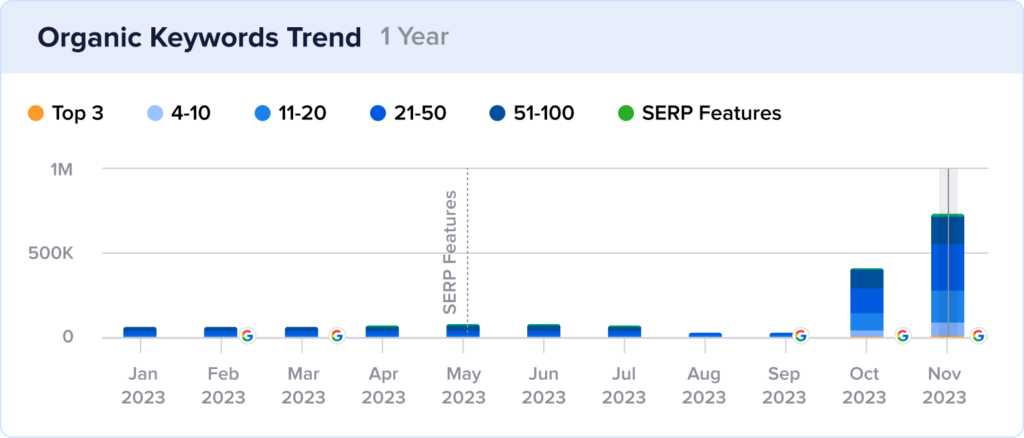
How to find new ranking opportunities for your site:
Finding new ranking opportunities starts with keyword research.
Keyword research is the process of discovering what your audience looks for in search engines. It also tells you the exact words they use when looking for it.
You can then use this information to create content tailored to their needs.
Here’s a comprehensive tutorial on how to perform keyword research using popular tools like Semrush, Ahrefs, and more.
We also recommend reading this article on topic clusters.
Topic clusters can help you organize your keywords and identify themes. They’re easy to learn and help you strategically build out your content.
Tools for keyword research:
Did you know WordPress users can perform keyword research directly in the editor?
AIOSEO connects with your Semrush account to make this possible.
Once you’ve set a focus keyphrase for your post or page, our Keyphrase Suggestions tool fetches relevant keywords for you.
Here’s an example:

If you Add Keyphrase, TruSEO will then analyze your optimizations for the new keyword.
Now, let’s look at how OED optimizes its factsheets to rank in Google’s People Also Ask box.
3. Leveraging Questions to Rank in Google’s People Also Ask Box
All factsheets follow the same template.
Headings capture popular questions related to the word, and the entry replaces the italicized word.
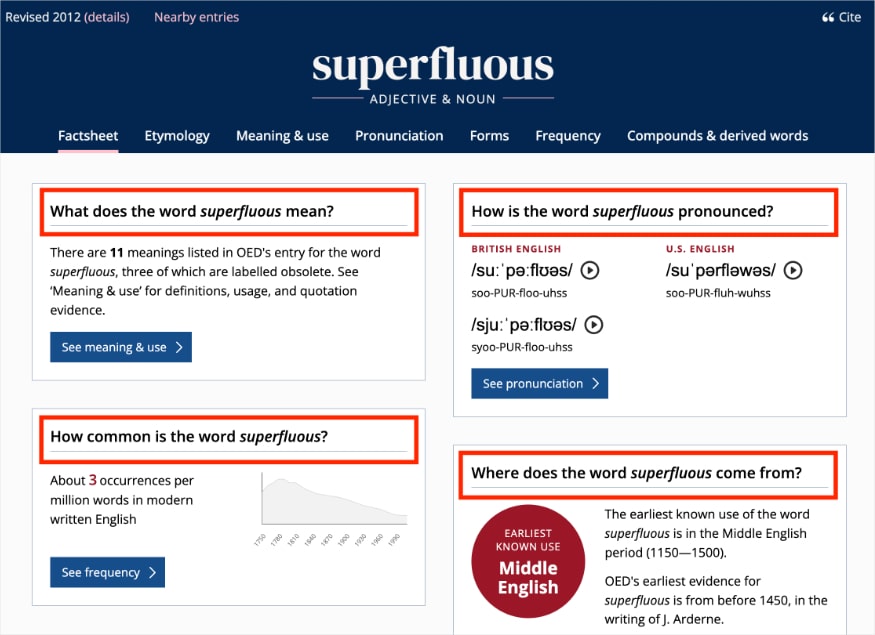
Question-based headings are a popular choice for SEOs and marketers.
They’re a powerful way to win rich results on the SERP and appear in Google’s People Also Ask (PAA) box.
The PAA box of Google presents users with related questions to their original query. It’s near the top of the search engine results page (SERP) and lists results in an accordion style.
Users can expand results to reveal the answer, as demonstrated below.

This answer was pulled directly from the factsheet for japery, as shown below.

In November 2023, OED ranked for 13K keywords in Google’s People Also Ask (PAA) box.
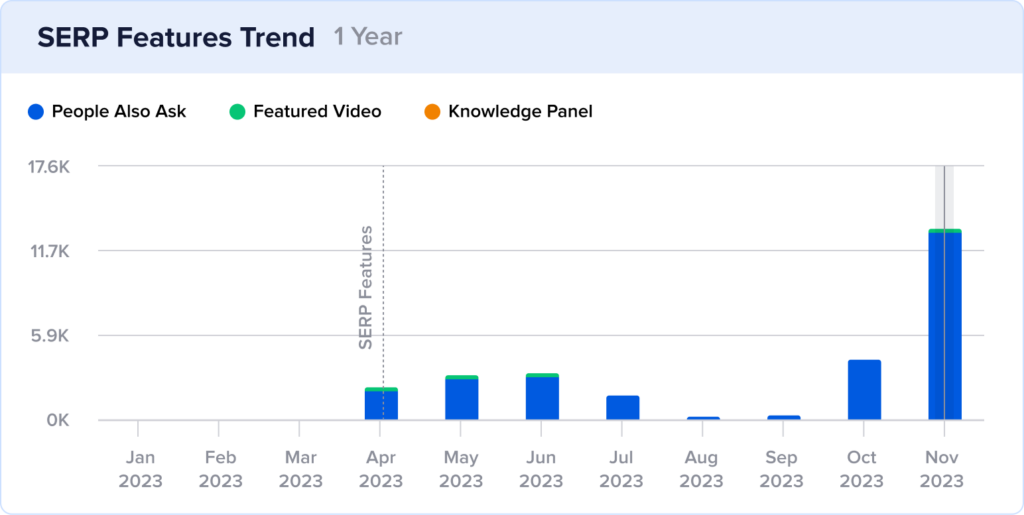
Why this matters:
PAA results take significant space on the SERP.
And the more SERP real estate you have, the better chance of catching users’ attention.
Here are some benefits from ranking in Google’s PAA box:
- Higher clickthrough rate (CTR)
- Increased organic traffic
- Greater brand awareness
- Stronger niche authority
- Better online visibility
How to optimize for PAA results on your site:
High-quality content is at the core of winning PAA results, but strategic optimizations exist to earn a coveted spot in Google’s PAA box.
Here’s an overview of the process:
- Locate question-based queries from keyword research.
- Craft content that answers search intent.
- Add FAQ schema.
- Conduct a competitor analysis.
For an in-depth explanation of each step, this guide tells you how to optimize for Google’s PAA.
Tools for PAA results:
FAQ schema plays an important role in winning PAA results.
FAQ schema is structured data that lives in your website’s code. Search engines can use this information to learn about your content and serve it as a rich result on the SERP.
For WordPress users, FAQ schema is easy to implement with AIOSEO’s Schema Generator.
Select FAQ from our Schema Catalog, and we’ll format it properly for search engines.

Standout SEO Wins
Before we conclude, there’s an additional SEO technique worth highlighting at oed.com.
1. They use canonical URLs to avoid duplicate content issues.
When exploring a dictionary entry, each tab generates a unique URL.
The main URL is the factsheet.
In our example below, this is oed.com/dictionary/eccentric_adj

And here is how the URL slug changes when you click the Etymology tab: /eccentric_adj?tab=etymology-paywall

Here are a few other examples:
- Pronunciation: /eccentric_adj?tab=pronunciation-paywall
- Forms: /eccentric_adj?tab=forms-paywall
- Frequency: /eccentric_adj?tab=frequency-paywall
Now, here’s the problem with having multiple URLs for the same word.
Even though the content differs on each tab, search engines can get confused about which one is the most important.
Unless you explicitly tell them, it won’t know which URL you want them to rank in search results.
A canonical tag allows you to do this.
Canonical tags tell search engines which version of a page is your preferred URL.
In the case of OED, those are their factsheet pages.
They don’t want paywalled pages to rank in search results, so they implement canonical tags to tell search engines to serve the factsheet URL.
Here we see one of these canonical tags in action:

Note: The above screenshot was taken from the All in One SEO Analyzer. This free Chrome Extension allows you to perform quick and easy competitor analyses directly in your browser.
Tool: Canonical URLs are easy to implement with the right tools. AIOSEO makes it easy to update your canonicals in the Advanced Settings tab.

Takeaways
In our analysis of oed.com, we’ve seen how a website redesign sparked an SEO-friendly initiative that’s produced impressive results.
Now, let’s recap which strategies to use on your website and which to reconsider.
Top 3 Strategies to Emulate
- Implement SEO-friendly URLs. Optimized permalink structures help users and search engines understand what your page is about. They can also improve rankings in search results and foster a positive user experience.
- Add new, indexable pages to rank in search results. By adding factsheets, OED enhances its discoverability. Search engines can now serve OED for various language-related queries, boosting their authority and online presence. As a website owner, you can apply this by expanding your site’s content portfolio with new, indexable pages.
- Optimize content for People Also Ask results. PAA results can improve CTR and traffic while boosting brand awareness. FAQs are a powerful way to optimize for these rich results and help position you as an expert in your niche.
Bottom 3 Strategies to Reconsider
- Not implementing schema markup. Schema markup provides details about the content of a page, encouraging search engines to use this information as a rich result on the SERP. OED doesn’t currently use schema markup but could benefit from DefinedTerm schema. AIOSEO’s Schema Generator makes it easy to add schema markup in WordPress.
- Missing self-referencing canonicals. Some of OED’s /discover/ pages are missing canonical tags. Even though these pages are unique and don’t have the same duplicate content issues as /definition/ pages, it’s still considered best practice to include a self-referential canonical. You can manage and customize canonicals directly in your AIOSEO settings.
- Lack of images. Multimedia keeps users engaged as they explore your content. They can also help you rank your site in Google image search, where there are over 1 billion searches a day. The image SEO tool can streamline your optimizations with smart tags that generate alt text and title tags automatically.
Steal Our SEO Winning Strategy: A Checklist for Your Website
Are you ready to leverage the Oxford English Dictionary’s bold growth strategies and our checklist for success?
We’ve got you covered with 50 SEO items to boost your rankings and grow your online visibility.
Download A Free SEO Checklist
Access our comprehensive SEO Checklist with a single click. We’ll deliver it straight to you, putting actionable items with SEO tools and tutorials right at your fingertips.
Enter your name and email to download a free SEO checklist.
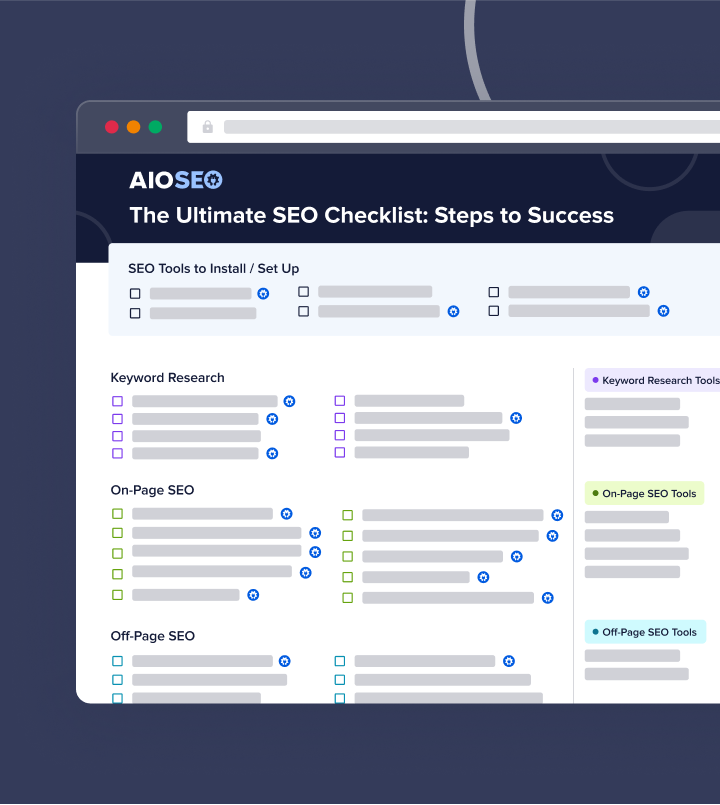
Embrace a New Way to Optimize With AIOSEO
Bring your website into its next era of growth with AIOSEO, the best WordPress SEO plugin.
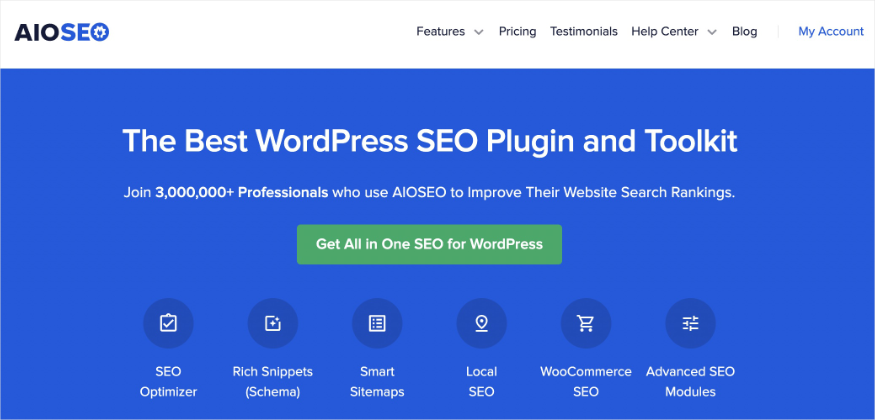
Trusted by over 3 million website owners and with thousands of 5-star reviews, AIOSEO streamlines optimizations so you can get results fast. You’ll gain access to a powerful suite of tools designed to take your website’s SEO to new heights.
Here are some of our favorite features:
- TruSEO On-Page Analysis: Get an in-depth but easy-to-understand analysis of your optimization efforts. Each page includes an actionable checklist to help you maximize your content’s reach.
- Redirection Manager: Create a seamless navigation experience that prevents users and bots from getting lost when you move content. Our Redirection Manager helps you easily choose and implement the best redirect type.
- Semrush Keyphrase Suggestions: Find new keywords without having to leave WordPress. AIOSEO connects with your Semrush account to pull keyword ideas from its database and serve them to you directly in the WordPress editor.
- Schema Generator: Our ever-growing catalog lets you pick and embed schema markup without touching code. Websites with schema markup get more rich results on the SERP, a proven way to win more traffic for your site.
- Image SEO: Turn on automatic image alt text and title tags with just 1 click. You’ll save time from manual entries while helping users and search engines understand your images.
- RSS Content: Does your site publish a lot of content? RSS sitemaps tell search engines when you’ve created or updated content for faster crawling. AIOSEO automatically generates RSS sitemaps for you.





